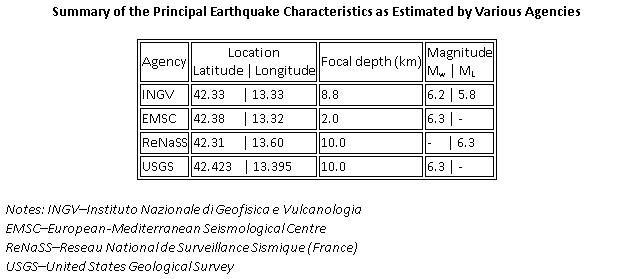First Posting | Summary
Posting Date: April 6, 2009, 9:27:00 AM
At 1:32 GMT (3:32 a.m. local time) on Monday 6 April, a strong earthquake struck the Abruzzo region of central Italy. The US Geological Survey has issued a moment magnitude estimate of 6.3 for the event. Italy's National Institute of Geophysics and Volcanology (INGV) reported a local magnitude of 5.8, which according to INVG equates to a moment magnitude of 6.2. Focal depth is estimated at 10 km. The shallowness of today's event has undoubtedly exacerbated the damage. Note that these seismic parameters may be revised as information continues to come in from seismic networks around the world.
A summary of the principal event characteristics provided by local and international agencies is presented below. With the exception of the French ReNaSS seismological agency, which has reported a local magnitude of 6.3, there is reasonably good agreement on the initial calculations of earthquake magnitude. The INGV reports an aftershock approximately an hour after the main shock (4:37 a.m. local time) with a magnitude of 4.6.

Using the estimated parameters issued by the USGS, early indications from the AIR Earthquake Model for the Mediterranean Region are that the insured losses are likely to be under 500 million Euros. Note that earthquake take-up rates for residential properties in the region are relatively low; hence damage to commercial properties will likely drive the insured losses. However, please also note that the AIR earthquake team continues to analyze today's event and will be making a full ALERT posting in due course. Clients will be notified when results and event sets are available.
The epicenter of this morning's earthquake was located about 6 km northeast of the hill town of L'Aquila, the provincial capital. The historic center of the town, which is home to about 70,000 permanent residents, was particularly hard hit. Local authorities report that thousands of buildings have been damaged, many of them severely. At least six students are feared trapped beneath a partially collapsed four-story university dormitory. Four children died from their injuries after the roof of their home collapsed. At least two churches have suffered significant damage, including the town's cathedral. The main hospital has also been damaged, prompting a partial evacuation.
Most of the significant damage seems to have been sustained by unreinforced masonry structures, which are characterized by their limited ability to resist earthquake lateral loads without cracking or suffering wall collapses. Damage has also been reported in several reinforced concrete structures in the area. The development of the seismic zonation in Italy throughout the last decades has led to levels of seismic resistance that vary according to region and building's age. Depending on the level of earthquake resistant design implemented in the local reinforced concrete structures, damage to beam-column connections, walls, and to other structural elements can be expected in this event.
Several towns and villages around L'Aquila were also affected, including Castelnuovo, Poggio Picenze, Tormintarte, Fossa, Totani and Villa Sant'Angelo. The quake was felt as far away as Rome, some 95 km to the west southwest. Gas and telephone lines have been interrupted, and electricity has been cut to some 15,000 homes. Landslides have blocked some roads and some bridges in the area have been closed for safety reasons.
Seismicity in Italy is largely controlled by the collision of the Italian-Adriatic peninsula against the European continental region, an interaction that has produced the western Alps and uplifted and thickened the Apennine belt. There is considerable variation in the level of seismic activity from region to region within Italy. However, the INGV classifies the Apennine mountain region as an at-risk area for major earthquakes. The focal mechanism of today's event suggests a normal fault related to the east-west extensional tectonics which dominate the Apennine belt.
The earthquake struck about 140 km from where a M5.9 earthquake that occurred in October 2002, killing 28 people, and 100 km from the Ms6.0 Umbria-Marche earthquake of 1997 in which 11 were killed.
The AIR earthquake team is analyzing the currently available seismological information for this event in the AIR Model for the Mediterranean Region. Clients will be notified when the results of that analysis are available on the ALERT website.
